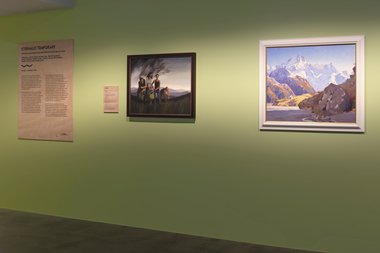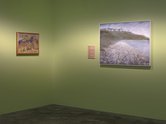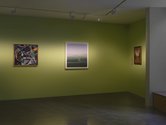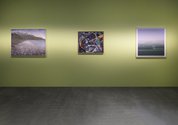John Hurrell – 5 July, 2024
Another aspect is a strange contradictory fantasy about Aotearoa's landscape having irrefutable scale and endurance: even though the ten paintings from the Kelliher Art Trust Collection show us how the activity of painting has changed, as has of course the impact of human habitation, livestock, crop production and weather patterns on the landscape. Even if—thinking far beyond the limitations of our own pitifully short life spans—the landscape appears to be eternally immense, it can never stay that way.
Titirangi
Derek Ball, Austen Deans, Michael Dell, Trenton Garrett, Aroha Gossage, Rodney Hamel, Imogen Taylor, Rex Turnbull, Robert Watson, Toss Woollaston
Eternally Temporary
Works picked from the Kelliher Art Trust Collection
25 May - 4 August 2024
With this conspicuously unusual show in a ‘serious’ art gallery, to see and recognise the listed names makes one suddenly sit up, for the Kelliher Art Prize is often mocked by the more high-brow members of the art community as encouraging chocolate box lid clichés. This, I thought I have to visit, as it so happens my parents owned an Austen Deans, and they hated contemporary art—but Toss Woollaston (whom naturally they loathed) is sitting in the same group.
For a start, the mixed selection of works is a welcome surprise. Admittedly a little baffling—because of the jarring diversity and because of the fact that these works normally pitch themselves to a community with no interest whatsoever in contemporary art. So is it intended as a gesture of appeasement to Waitakere audiences? No, it is genuinely interesting. (No need to patronise the locals. With the wide selection there is probably something there for everyone.)
Another aspect is a strange contradictory fantasy about Aotearoa’s landscape having irrefutable scale and endurance: even though the ten paintings from the Kelliher Art Trust Collection show us how the activity of painting has changed, as has of course the impact of human habitation, livestock, crop production and weather patterns on the landscape. Even if—thinking far beyond the limitations of our own pitifully short life spans—the landscape appears to be eternally immense, it can never stay that way.
So we ponder firstly: what is landscape and the forces that shape it? (to be suitable as subject-matter for paintings that get purchased by the Kelliher organisation in the first place), and secondly what is ‘environmental?’ (for images to be placed in this pool of national ‘eco-related’ projects). Are there consequences that are apparent?
The two earliest works here were painted in 1962, and the most recent in 2022, so in between we wonder about different emerging art ideologies (developing social realisms, possible avant-garde movements and retro re-emergences) underpinning regularly clashing styles and subject-matters. We look back from 2024 and try to interpret these now historic (somewhat ‘innocent’) images via the legitimately alarming lenses of well-informed contemporary panic—and not get too rattled by inevitable deficiencies in weather-ravaged landscape description.
As is common these days in the artworld, the wall discussion of the curation tends to stress the cultural background and personal attributes of the artists themselves rather than looking closely at the characteristic imagery they have produced (especially the detectable ecological consequences that can be elaborated on via close environmental observation). It is a major weakness because the brief of looking at ecological impact is impossible to demonstrate through this variety of non-conceptual painting genre. It is hampered by limited expectations of what the evocative and descriptive activity of ‘landscape painting’ might be.
However the introductory wall label does acknowledge many of these issues—especially when discussing ‘deforestation and the introduction of agriculture.’ The problem lies within the nature of this sort of art practice which is a far cry from say, more pertinent geological, geographical or climate research. Nevertheless, it would be possible to radically transform ‘Kelliher painting’ (through more adventurous commissions) so it can embrace far more explorative (and perhaps more overtly soil connected) activities. These would merge with other disciplines—and could even hang on walls too.
John Hurrell




 Two Rooms presents a program of residencies and projects
Two Rooms presents a program of residencies and projects Advertising in this column
Advertising in this column



This Discussion has 0 comments.
Comment
Participate
Register to Participate.
Sign in
Sign in to an existing account.